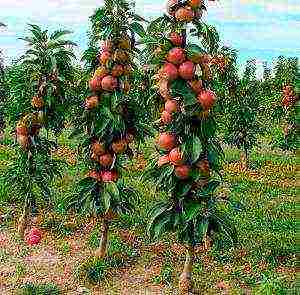Content
- 1 Observation, which provided the emergence of a new type of horticultural crops
- 2 Benefits of Columnar Apple Orchards
- 3 Biological features of columnar apple varieties
- 4 Types and varieties of columnar apple trees
- 5 Columnar apple varieties by growing region
- 6 general characteristics
- 7 Description of varieties and photos
- 8 Useful videos
- 9 Conclusion
- 10 Why are columnar varieties of apple trees good?
- 11 Currency
- 12 Iksha
- 13 Baby
- 14 Moscow necklace
- 15 Ostankino
- 16 The president
- 17 Amber necklace
- 18 What should be considered when growing columnar apple trees?
- 19 Russian varieties of columnar apple
- Part 1. Columnar apple trees - features and the best varieties
- Part 2. Features of growing columnar apple trees
Apple trees bloom - what a miracle, but not every gardener can handle them. Apple trees are not resistant to a number of diseases and pests, but the large height of the tree and the spreading crown are often inaccessible for full-fledged care. Therefore, a new type of apple trees with a small bush habit and intense fruiting is a real find for small summer cottages and private plots. Columnar apple trees are a worthy compromise when deciding to change the design of a site or landscape design, with the laying of "phytowalls" on a bed of apples of different colors.
Columnar apple trees planted along the fence
Observation, which provided the emergence of a new type of horticultural crops
The appearance of the type of columnar pome fruit (apple trees, and later pears) is not more than 50 years old. It started with observation and healthy curiosity. On one of the old apple trees, the owner noticed a branch that outwardly differed from the rest of the branches of the crown. The branch was distinguished by vertical growth without lateral branches, it was all covered with ringlets and spears. It was a typical spontaneous mutant obtained in vivo on a Macintosh apple tree. The branch was multiplied and received an original variety, which was named Vazhak. The triumphant march through the world of the columnar type of apple trees reached Russia and in 1972 the local type of columns was first obtained from crossing the varieties Vazhak and Korichnoye Polosatoe. At present, the number of varieties has exceeded a hundred, and the area under the gardens is over many hundreds of hectares of private dachas and house plots.
Benefits of Columnar Apple Orchards
- The ability to grow a large list of crop varieties in a small area
- Carrying out full-fledged care.
- The main feature is the small size of the crown habit and root system.
- High decorativeness.
- Intensive and early fruiting (1-2-3 years after permanent planting),
- High taste inherent in common apple varieties.
- Convenient harvesting.
Fruits of a columnar apple variety Sonata
Biological features of columnar apple varieties
A beneficial mutation was caused by a lack of growth hormone, which determined the type of crown and habit of the culture. The violation contributed to the enhanced laying of flower buds (leaving offspring), that is, the early return of the crop (by 1-3 years).
The biological feature is the almost complete absence of lateral branching, the formation of a crop on the central shoot (trunk) of the tree, a dwarf type of growth and early maturity. With small sizes, apple trees bear fruit constantly, yielding significant yields. At the same time, they also have weak points - the root system. It is superficial, underdeveloped, poorly holding the aboveground part of the culture, and under the gusts of wind, the tree trunk may break.An insufficiently developed root system is not able to provide the plant with a sufficient amount of moisture and nutrients, therefore it needs feeding and watering, but does not tolerate overfeeding and high humidity. Columnar varieties have an intense type of fruiting, and since the central shoot is involved in its formation, the main part of the fruit formations dies off, starting from the bottom. Fruiting shifts gradually upward. Having reached the top point, fruiting stops. The tree ceases to form fruits, although it continues to function until almost 50 years of age.
Varieties of columnar apple trees are distinguished by their early maturity. Some bloom in the year of planting (Malyukha, Barguzin, Iksha, Moscow necklace, X-3). But leaving the harvest in the first year is impractical... Having given all her strength to the formation of fruits in the first year, she may not plant the harvest the next. The duration of active fruiting in columnar apple trees does not exceed 6-8 years. Most varieties are medium-sized crops that enter into active fruiting by 3-4 years after permanent planting. Late fruits form a crop 6 years after planting. When buying seedlings, be sure to ask the seller for an accompanying characteristic of the variety, which should indicate the main biological characteristics of the variety. Otherwise, you can buy an absolutely unpredictable variety, species and type of plant.
Types and varieties of columnar apple trees
Like ordinary apple trees, columnar in habit are divided into several groups:
- superdwarfs,
- dwarfs,
- half-dwarfs,
- medium-sized,
- vigorous.
In home gardening, two types of columnar apple varieties are most acceptable - dwarf and medium-sized.
Dwarf columnar varieties are obtained by grafting clonal grafts "with the Co gene" on dwarf rootstocks. Saplings grow slowly, but they are able to form a crop throughout the trunk from the first year. In this group, the most common varieties are Currency, Arbat, 003.
Medium Columns are obtained artificially by grafting conventional varieties onto super-dwarf clonal rootstocks and subsequent formative pruning. Compact trees up to 2.5 m in height are obtained.
The most famous varieties with an artificial columnar shape are Brusnichnoe, Orlinka, Ligol, Vasyugan, Medok, President, Amber Necklace, Moscow Necklace, Bolero, etc.
At the columns, ring-type fruit links are located along the entire trunk. Ringworms bloom and bear fruit profusely. In addition to fruits, leaves are formed on the ringlets, as a rule, of dark green colors and shades. Terminal growths are vertical, short, with a large number of closely spaced internodes. Such varieties are called spurous... They are characterized by a compact crown, a weak ability to form shoots, an insignificant height of apple trees within 2.0-3.0 m in height. Most valuable rootstock-dependent inheritance. Therefore, when buying seedlings, be sure to take an interest in parental pairs.
For grafting in order to obtain dwarf columnar varieties, two types of rootstock are mainly used:
- superdwarf rootstock PB-4 (Paradizka Belorusskaya), which is used in the southern regions;
- super-dwarf rootstock Kid Budagovsky. Stock for grafting in central Russia.
Both types are characterized by increased fragility. Therefore, when planting and leaving, careful and careful handling of seedlings and mature trees is necessary.
When buying stock for grafting at home, pay attention to the color of the bark of the seedlings. The bark color of PB-4 is light green with a yellowish tinge. The seedlings of Malysh Budagovsky have an intense purple-red color. This feature will help distinguish a true super-dwarf stock when purchasing.
The stock of ordinary apple trees is not suitable for columns. Vigorous seedlings lose the main sign of crown construction (single-stemmed, without lateral skeletal branches).
Columnar apple varieties by growing region
Like ordinary apple trees, columnar varieties are subdivided by resistance to climatic conditions into frost-resistant and thermophilic.
Columnar apple varieties for the southern regions
For the southern regions, the best varieties of columnar apple trees are considered - Bolero, Yesenia, Trident, Snow White, Taskan, Sparkle, Garland, Green noise, Titania, White eagle, Senator, Ideal. They are quite resistant to cold snaps in southern climates, but do not tolerate severe frosts.
The varieties are late-ripening autumn varieties with good long-term keeping quality of fruits. Fruiting begins in the third year of life. Fruits reach 150-400 g. Slightly conical in shape, round, rounded-flattened. By color of various colors - from the predominant green to red. 2.0-2.5 meter tall beauties with a compact crown, the volume of which does not exceed 0.5-0.7 m, they are a true decoration of the garden. Leafy, they retain a high decorative effect during the entire warm period. They are especially smart in their ridges, forming an extraordinary phytowall that adorns the paths to the house, resting corners.
Columnar apple varieties for the Central Chernozem and Siberian regions
Every year, varieties of apple trees with an unusual crown and fruiting are moving further to the north. Life expectancy with active fruiting in these regions does not exceed 6-8-12 years. To the best varieties with good winter hardiness for growing in the middle and Siberian regions (from the Moscow region to the Urals) include Vasyugan, Moscow necklace, Senator, President, Ostankino, Triumph, Currency, Arbat, Medok, Jin, Dialogue, Renet Mazherova, Iskorka, Chervonets, Elita, Iksha and others. Of the above, the varieties Iksha (-40 ° C), Vasyugan, President, Moscow necklace are distinguished by exceptional winter hardiness.
Medium winter hardy (for the climatic conditions of the Moscow region) with high taste - varieties of columnar apple trees: Malyukha, Medok, Arbat, Moscow necklace and others. Interesting varieties Medoc and Renet Mazherova. Medoc has a unique aroma and taste of honey, begins to bear fruit from the first year of life. Renet Mazherova has the narrowest crown (no more than 40 cm in diameter), small fruits (50 g), which literally cover the trunk in August-September, resembling a fantastic ear of bright yellow color. Juicy aromatic pulp of creamy yellow color leaves a unique aftertaste. It should be noted that all of the above varieties are high-yielding and early-growing. Sourness is inherent in apples, giving a piquant taste to the fruit. The small dimensions of the plants allow, even in a small area, to concentrate a significant number of varieties with different ripening periods, quality indicators, fruit size and color.
Columnar apple trees planted along the fence
To increase the decorativeness of plantings, you can combine several universal varieties of columnar apple trees. Column varieties differ in apple color, flowering period, giving special uniqueness to plantings. So you can plant a rabatka in 1-2 rows from the following varieties: President with light yellow fruits, Ostankino with large red apples, Vasyugan with red-striped ones, Amber necklace with green-yellow fruits and pale pink blush. Frost-resistant Iksha will decorate a living phytowall with apples, orange with a red-striped blush, round-flat in shape, a fabulous saffron aroma. Separate groups of columns with golden yellow, bright yellow, yellow-green fruits (Currency, Dialogue, Maluha) look great.
Columnar apple trees, especially in the early years, require patience and attention. Planting and care, feeding and pruning have their own characteristics. Therefore, before laying a garden or a separate small plot in the form of several separate groups or a row along the path, you must first draw a planting scheme in the garden diary indicating the row spacing and distance in the row, varieties with a brief description of the main features, and in the spring start purchasing seedlings.
You can familiarize yourself with the peculiarities of planting and caring for columnar gardens in the second part of the article "Features of growing columnar apple trees". (Currently the material is being prepared)
- Part 1. Columnar apple trees - features and the best varieties
- Part 2. Features of growing columnar apple trees
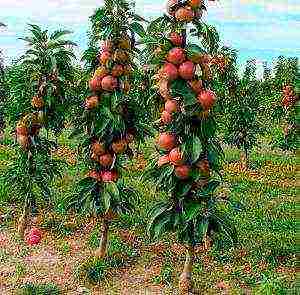 To be an apple tree in the garden, or not to be? There is no such question. Of course to be. And not just one. Not so long ago, we wondered how to have apple trees, pears, cherries, apricots, plums on a dedicated summer cottage. And, of course, not in one copy.
To be an apple tree in the garden, or not to be? There is no such question. Of course to be. And not just one. Not so long ago, we wondered how to have apple trees, pears, cherries, apricots, plums on a dedicated summer cottage. And, of course, not in one copy.
Yablona was traditionally allocated a place for 3-4 trees. And the torment began with the choice of varieties. After all, there are excellent varieties of different ripening periods. And I wanted to eat them from summer to winter.
Somehow, amateur gardeners managed to vaccinate and have about 10 varieties. And this was a testament to the success.
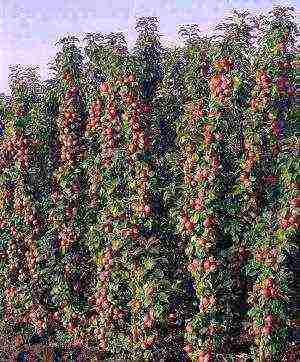 No one denies the possibility of many varieties being vaccinated today. But the very idea of the garden and apple trees in the garden has changed:
No one denies the possibility of many varieties being vaccinated today. But the very idea of the garden and apple trees in the garden has changed:
- Farmer thinks of a garden quickly bearing fruit. Profitable quickly. After all, the costs of laying an industrial garden are quite impressive. New technologies and varieties make it possible to do this;
- Amateur gardener still wants to have many good varieties. And somewhere nearby there is a desire to have a beautiful garden;
- Now many people allow them to have not just a plot of 15-20 acres. And farmsteads even under a hectare are not so rare. And here the beauty of the site comes to the fore. The eye should be pleased with the variety of plants, the most amazing forms.
AND for all, the columnar apple tree is a godsend. Not so long ago, little was known about her. Now there is a lot of information. Internet, nurseries, design, planting and grooming specialists.
general characteristics
And first about the columnar apple tree itself. Appeared relatively recently. 1964 is considered to be the year of the creation of the first variety of a columnar apple tree with the name Leader... It appeared as a natural mutation due to the care and interest of the gardener. He didn't miss a strange branch on a perennial Macintosh tree. Which caught his attention:
- Apples, placed right on top of one another, plump. But of the same sort;
- Strong foliage and lack of lateral branches;
- Patience and hard work led to the development of the first grade. An amazing ability to experiment has led to the creation of more than 100 varieties of columnar apple trees;
- AND our compatriots relatively quickly created dozens of varieties of columnar apple trees, capable of delighting with crops in difficult climatic conditions. Highly resistant to Russian frosts and diseases. In addition, the taste is not much inferior to traditional apples. But there are other valuable qualities as well;
- And put my hand to it famous Russian scientist and breeder, Doctor of Science and Professor Viktor Valerianovich Kichina... Not just a hand. But also the mind. Modern Michurin. Creator of over 20 varieties of apple trees. And he has no equal in breeding raspberries - 25 varieties.
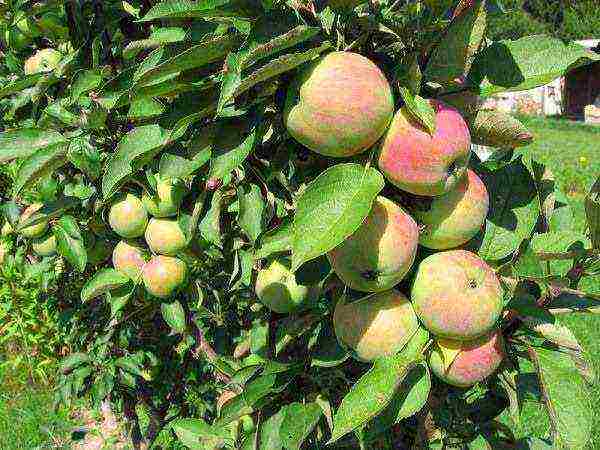
The first columnar apple tree Leader.
Advantages of columnar apple trees:
- Small crown forms - up to 3 m high and about 50 cm wide. And count how many such trees you plant instead of the vigorous Antonovka with its impressive forms. Many designers can no longer imagine a garden without columnar apple trees. Both in plantings and vases;
- Very fast entry into fruiting. Starting from 5-7 apples in the second year after planting. And annually 5-15 kg from 4-6 years of age;
- Large selection of varieties with high resistance to frost and disease;
- Small forms make their care more convenient in handling, pruning, and harvesting.
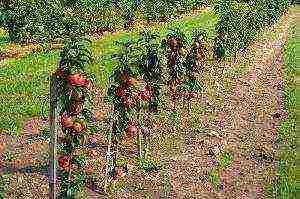 Don't forget about the disadvantages:
Don't forget about the disadvantages:
- Comparative high cost of seedlings;
- You can enjoy stable harvests for a short time. Only up to 15-16 years of age. This is their nature;
- Forget about moisture and feeding - you will not get even a minimum yield.
Description of varieties and photos
The president
- By ripening time as early, summer... In late August and early September, the apples are ready for picking. You can save until December;
- Height can be up to 3 meters. Semi-dwarf, medium vigor tree. Bears fruit in gardens every year 5-7 kg per tree... And even 10 kg. From 5-6 years of age. Single trees may also have periodic harvests;
- Average weight of greenish-yellow apples with pinkish blush from 130 g to 200 g... And there are copies of 250 g each;
- Sweet and sour creamy juicy pulp with a dessert taste;
- High winter hardiness (up to 40 degrees of frost allows you to grow in the gardens of central Russia. Zoned back in 2002. And even in Siberia and the Urals.
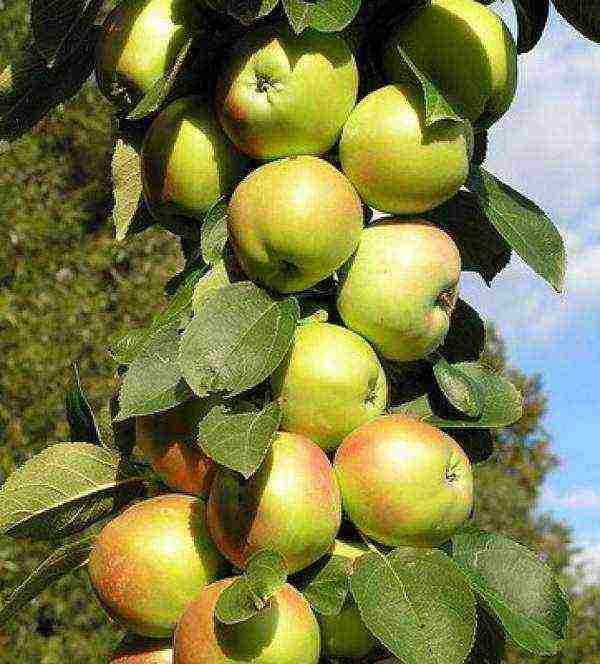
The president.
You can read more about the President apple tree here.
Reviews about the apple President:
Konstantin. “Only three years have passed since the planting of the President variety. My expectations were met. There are not many apples compared to regular varieties. But he took it as exotic. And after all there will be more. But I was surprised by their ability to persist until December and their pleasant taste. We ate them without waiting for December. And they could also lie down. I didn't feel the dessert. "
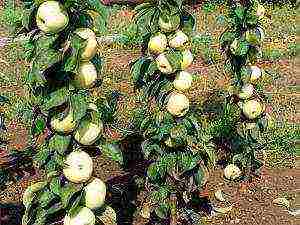
Yuri. “I was looking for a columnar apple tree for our places. The President was advised. Not very well known. Thanks for the tip.
Satisfied with the dessert taste. And sweets and acids in moderation. Slightly lying down seemed to me tastier. True, my wife prefers our old varieties.
I also like their compactness and ease of maintenance. "
Marina. “I would like to share my impressions of the planted apple-tree President. It's not a winter variety, though. But even until December there were apples. Almost 2 months! Don't forget feeding and watering. The yield increases dramatically. This is on condition that you take care of a good wintering. Hares oh, how they love columnar. I cover the apical kidney. "
Nectar
- How many of us are not familiar with the taste of honey? And if we meet it in the names of varieties of fruit-bearing plants, then we are waiting for its taste. But there is still enough honey. Despite its prices;
- Here is the variety of columnar apple trees Medoc remind you of the taste of honey and its shades;
- The golden color of apples with a characteristic honey flavor. Collect in September. And something else in August. And even a kilogram so under 10. But apples are quite large. More than 250 grams;
- And some more TTD -height up to 2.5 m... Apples and weighing 250 g. And from a tree - 10 kg.
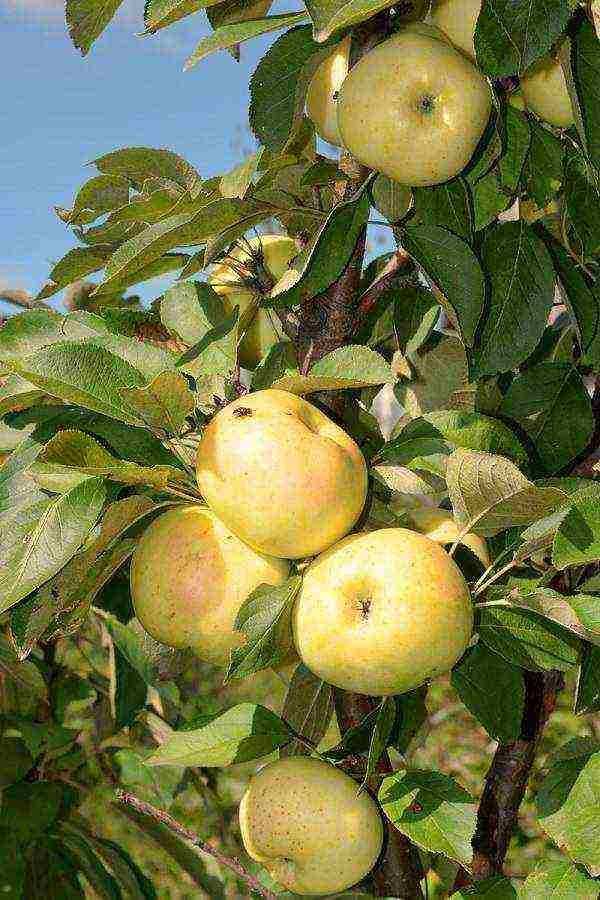
Nectar.
You can learn more about the Medoc apple tree here.
Reviews about the Medoc variety:
Elena. “Have you ever tried the Medoc apple variety? Of course, a columnar apple tree. If you haven't tried it, do it. There is honey. Everyone feels it differently. Have you eaten honey? Remember, of course, its taste. So you will find it when using the Medoc apples. Both when removed from the tree and after storage. The taste is practically unchanged. "
Nikolay. “Friends suggested a sapling of a columnar apple-tree Medoc. There was no choice. Had no idea about columnar apple trees. They talked about the main thing. Don't touch the center conductor. And did not touch. It grows and does not bear fruit. Can you cut it off somehow? It's been 5 years already. But there are no apples. Even flowers in the spring. They advise to wait a little longer. "

Natalia. “But I really liked the Medoc variety. Every man to his own taste. So for me this variety.
Only 10 apples. And this is the 8th year.
But delicious! And when you look at this baby, you just want to say thank you to her! "
Currency
- Winter variety. An indisputable achievement of breeders. He still scab immune with Vf gene... Which allows you to think less about apple tree diseases. Less, but don't forget;
- They are visible in the garden. Their green foliage stays on the tree for a very long time. So are the fruits. Filmed slightly immature in the first half of October. After all, you have to lie down almost all winter;
- And the height fluctuates between semi-dwarf and even dwarf. Therefore, it grows not higher than 2.5 m;
- Large apples up to 200 g are very good. aromatic sweet and juicy white pulp;
- Entrepreneurs and farmers have been interested in it for a long time.
Consider:
- Moisture moisture. BUT high groundwater is not suitable for the variety;
- Pay attention to timely feeding;
- Dislikes shading.
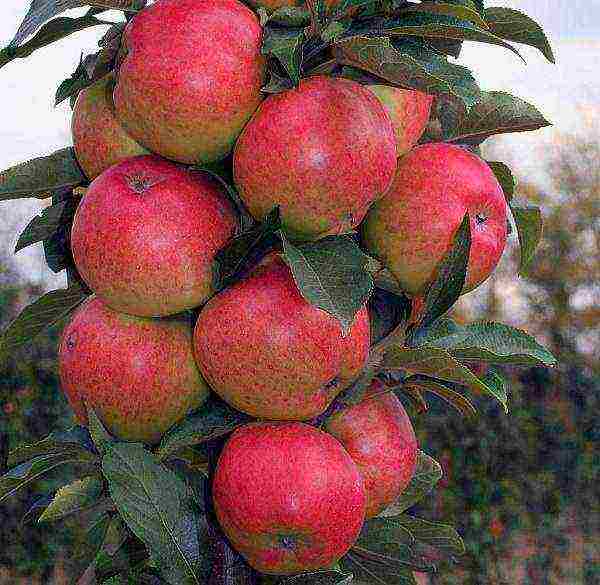
Currency.
Read more about Apple Currency in this article.
Reviews about Column Currency:
Oleg. “Currency is Currency. Of course, care cannot be started. Reacts very strongly to lack of moisture and feeding. I have more than a dozen of them. Somehow I have already worked out a system. It's simple. I even want to bring it up to two three dozen. Not many apples - but tasty. I like not only me. And I will also equip drip irrigation. Appeared not so long ago. But lovely. And the apples are one to one. Large and clean. "
Yuri. “The currency lives up to its name. A find for the gardener of Siberia. Amazing frost resistance. Out of habit, I treated them twice a season against diseases. I still treated pests. But they have a magnificent view. I'm not talking about apples. They did not save it until March. They ate it. And we could still lie down. Sweet and aromatic. The whole family loves them. You can even plant a couple of this kind. "
Triumph
- Whoever gave such a name, of course, meant a victorious march in all positions. And a lot is true;
- Autumn variety with very comfortable shapes. Small-sized up to 2 meters in height thanks to the stock MM-106 and 54-118;
- Medium sized apples weighing about 130-150 grams. Find larger ones up to 200 A. removed mature in mid-September. And we must take care of the consumption and processing. After all stored for only a month;
- BUT the yield is quite good 5-7 kg... This is the starting point for the gardener. After all, proper care will even double it;
- A deep red blush over the entire surface of the fruit. The honey-sweet dessert taste is memorable. And the sourness does not interfere;
- TO not susceptible to disease grade, immune to scab, frost resistance for the middle lane is average.
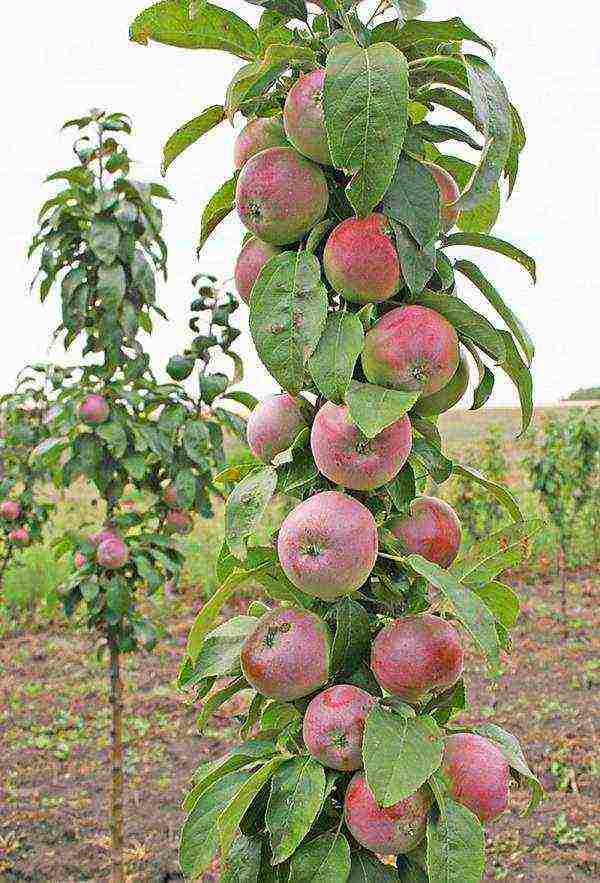
Triumph.
You will learn more about the Triumph variety from this article.
Reviews of gardeners about the Triumph:
Olesya. “They say correctly that whatever you name the ship, so it will float. Here is the Triumph variety. Though not late. But he has already won love and respect. So far (and this is already 5 years) no treatments for diseases. Would be taller. And there would be more harvest. But look at the apples. Handsome men. The juice and jam are excellent. And the pies. This should be tried, not told. If only we could lie down longer ... "
Evgeny. “There are no problems with which variety, it is Triumph. Only pests need to be fought with preventive treatments. The apples are very juicy and sweet. Didn't even think about recycling. They ate the whole harvest. Almost a bucket of 10 liters. If there were no other autumn varieties, I would have planted 2-3 more of this variety. It is not for nothing that it is considered one of the best autumn ones. And no worse than ordinary apples. "
Baby
Very often in nurseries they ask for this autumn variety columnar apple trees of Russian selection:
- That is why they called it that. Due to the height of the tree. From the nature of a bonsai;
- Already in the first year of spring planting, the most impatient can taste the first apples. From the age of 4, they bring full-fledged harvests;
- It is almost apples of the same size, greenish-yellow with a pink tint;
- You can take your time to consume or process apples harvested in September. They can wait a couple of months. Almost until December;
- And in taste, it competes with the most delicious ordinary apples. Sweet and sour juicy pulp. The aroma is also felt... They are even called dessert;
- Resistance to disease and frost allows us to consider it a zoned variety for central Russia. Not to mention the more southerly places. But you need to prepare for the winter in full.
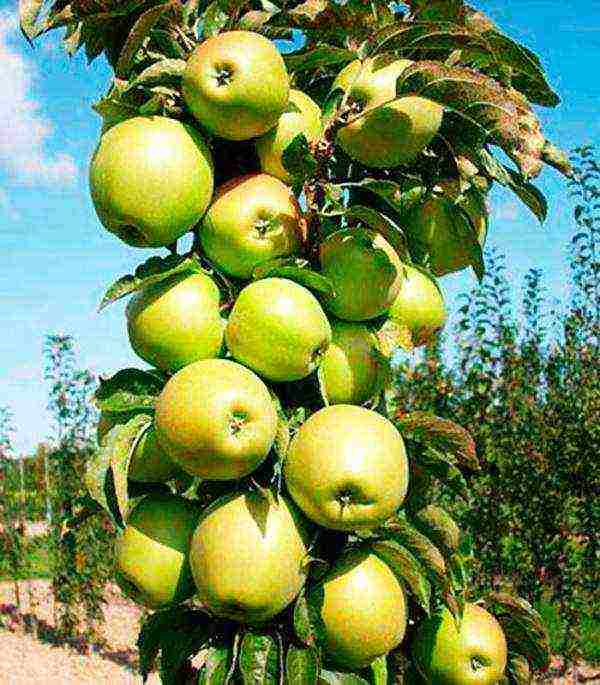
Baby.
You can read more about Malukha's apple tree here.
Reviews about Malukha:

Yaroslav. “I have never met apples tastier among columnar apples. Maybe for now.
Real dessert taste. Very juicy. If you try it once, you will never forget the taste. It's like the taste of Antonovka and White filling inimitable.
And a very pleasant yellowish flesh color. My friends are also delighted with them. They are already looking for seedlings of this variety in nurseries.
They don't hope for a vaccination. "
Olga. “It is a pleasure to look after such a variety as Malyukha.The ladder is definitely not needed. I believe that if you have 2-3 columnar apple trees, consider planting another 5-6. You can take care of them without any problems. Wholesale to prepare feeding and processing. Malukha's apples are worth it to plant another 1-2. And this is not only my opinion. "
Sergei. “I didn't succeed in growing a columnar apple tree. I bought the Malukha variety at the fair. Courted as taught. And the crown is formed correctly. Already the sixth year has gone after landing. And I don't see flower buds. Familiar gardeners are somehow skeptical about such apple trees. The preference is given to the traditional and proven. But I will still wait. "
Amber Necklace
- Winter grade Russian selection, for which their trademark advantage is high winter hardiness. Grown for such conditions;
- Apple trees belong to semi-dwarf and grow up to 2.5 meters;
- Ripen in September for assembly. But you will only eat in a couple of months. After lying down for this time, they acquire a characteristic taste (dessert and sweet) and color (golden with a one-sided blush);
- Apples of medium size and weight - 160-180 grams;
- The yield of the variety pleases fans of columnar apple trees - up to 15 kg per tree. But they collect up to 20 kg. This is from trees 6-7 years old.
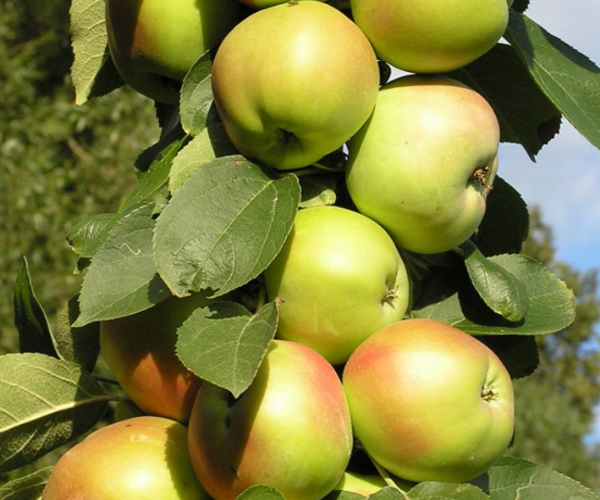
Amber Necklace.
You can find out more about the Amber Necklace apple tree here.
Reviews of the owners of the Amber necklace:
Tatyana. “What you see in the photo is only a fraction of the good impressions of this variety. No growing problems. I do not consider fertilizing and watering to be some kind of costly action. This is the norm. But apples with their taste will convince you of the need to grow this variety of columnar apple trees. Or maybe not from one tree. The impressions from him are the best. "
Michael. “Try to find the best columnar apple variety suitable for growing in our environment. And not only columnar. But this amber necklace is generally classy! I suffered with large crowns ... And here is a small, neat one ... No problems with shelter for the winter. And the fact that there are not many apples is not a problem. They pleasantly surprise even with a small amount. "
Ostankino
- Another variety of autumn ripening period... If you remove the apples in September, they can last even until December;
- Stunted tree with very strong trunk and branches. They are able to withstand bountiful harvests. And they are regular from 5-6 years after planting. And 6-9 kg per tree. And even 16 kg with careful care;
- Apples grow almost from the ground. 30-40 cm from its surface;
- Even in unfavorable weather for flowering, the ovary is consistently high;
- The fruits do not differ in the same size. Them the weight is 100, 150, and 200 grams;
- Very beautiful apples with a shiny reddish color. Sweet and sour and juicy. The dessert is also felt.
Important! A very resistant variety to diseases and frosts.
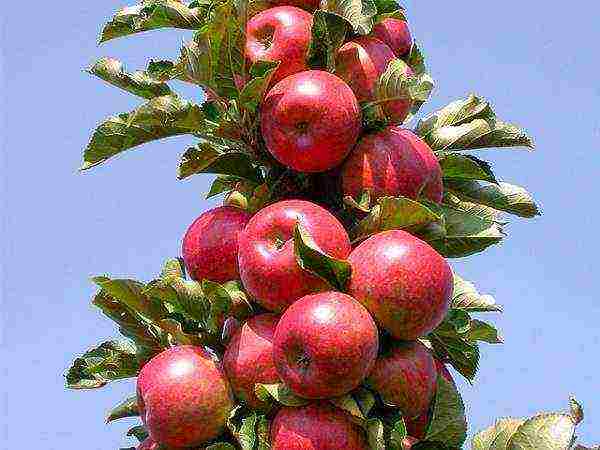
Ostankino.
Read more about the Ostankino apple tree in this article.
Reviews about the Ostankino apple tree:
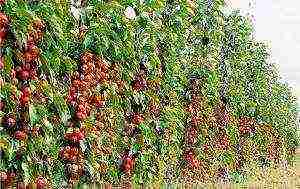
Oksana. “The columnar Ostankino apple tree has been growing for me for four years now. Subtracted on the Internet and purchased the nursery.
When buying a complete educational program with me. I want to say very useful. What you read is not all. Moreover, the opinions are different. I
we are already eating blocks for 2 seasons. They only made me happy. First, I bought what I wanted. And apples are large and tasty.
I don’t know how many will be stored yet. And this is not the most important thing. "
Anna. “I can share my opinion about the Ostankino columnar apple variety. I really like apples. True, there are not many of them yet. But this is not the only apple variety I have. And for a change. And to decorate the festive table. And they do not stay in the vase for long. I do my best to yield more than a bucket. "
Stepan. “Until I arranged drip irrigation, yields of columnar apple trees were 4-5 kg. He began to pay more attention to feeding. And already under 10 kg is. They will still grow up. And the dimensions of Ostankino have become more impressive. Even without weighing it is visible. So I advise others not to suffer from watering with a hose.And do not torment the trees with cold water. But it will not be superfluous to irrigate with a hose. 2-3 times a season in the evening. "
Moscow necklace
- And it was called at first as X2. Although some gardeners still call it that. Maybe not to be confused with the Amber Necklace? Very popular in the Moscow region, in the Urals. And even in Siberia;
- Low tree - up to 2 m. But they grow up to 2.5 m. It is classified by specialists as a dwarf;
- Like everyone else, she loves the sun. Light and fertilized soils;
- The ripening dates for apples come at the end of September. And here and there in early October. Yes and stored for 4 months... And even longer when. How do you store;
- Dark red apples with average weight 170-180 grams the taste is sweet. But with sourness;
- Frost resistance is one of the highest among columnar;
- And he successfully resists diseases;
Consider! The cultivar itself is not pollinated. So, plant in the company of other apple trees.
- There is also a tendency to form a large number of ovaries. Adjust it early (flowering and small apple sizes).
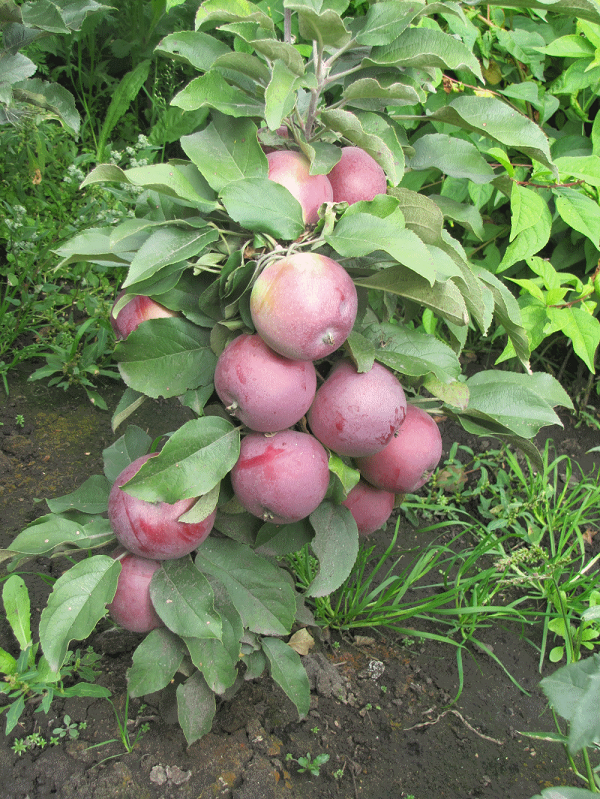
Moscow necklace.
You will learn more about the Moscow necklace variety from this article.
Reviews about the variety Moscow necklace:

Alexei. “I didn’t know that the variety is an individualist. Itself is not pollinated. I took it for a change. And now for everyone a feast for the eyes. Although far from columnar.
I was afraid to cut off. They talked about the apical kidney. If it disappears, the whole apple tree will also disappear. Not lost ... And the apples are amazing. Although I know the best.
Friends agree with this. Which I treat with these apples. "
Bogdan. “We always have problems with growing an apple tree. We didn't even hope that this apple tree would bring at least some apples. We were wrong. God forbid to be so wrong! We are not overjoyed with the apple tree. And we advise others. And apples and their taste. They can also lie down for a long time. We will see! And I heard that this is one of the best columnar winter varieties. "
Summer
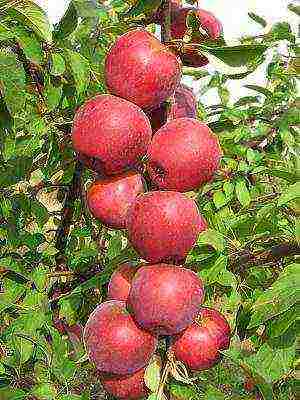 As soon as we start listing something, confusion arises. It was not included ... And it should not be ... So with apples. And not only columnar ... But we will dare and call them.Early columnar apple trees:
As soon as we start listing something, confusion arises. It was not included ... And it should not be ... So with apples. And not only columnar ... But we will dare and call them.Early columnar apple trees:
- Nectar;
- The president;
- Chervonets;
- Ray;
- Ideal;
- Flamingo;
- Cheremosh;
- Iksha. And many others.
You can also find a description of the following varieties on our website:
- late summer:
- Scarlet Sails;
- Arbat;
- Vasyugan.
- winter:
- Idol;
- Gin;
- Favorite.
Also, columnar varieties are divided by growing region. You can read more about this in this article.
Useful videos
Watch a video of what the Medoc and President apple trees look like:
Watch a video of what the Arbat apple tree looks like:
Watch the video of what the apple tree looks like Currency:
Watch a video of what the Ostankino apple tree looks like:
Conclusion
I have not yet met admiring reviews of the columnar apple trees from farmers anywhere. Or their press services. We didn't have time to prepare the text. Or they didn't grow decent harvests. Or is productivity not on track?
So we will wait for their positive feedback. Tips and tricks for the many varieties of columnar apple trees. All regions.
Like every normal (neighbors consider it not normal) gardener, I always wanted to grow in my garden much of what is not in every garden. I have been testing varieties of columnar apple trees for 20 years already. Or are they testing me? You can tell by touch.
We offer you 7 of the most productive, disease-resistant and popular among gardeners from different countries varieties of columnar apple trees with very tasty fruits.
Saplings of columnar apple trees appeared on sale relatively recently. But during this time they have already gained wide popularity. These neat trees are ideal for small areas. But this is only one of the advantages.
Why are columnar varieties of apple trees good?
The main advantage of columnar apple trees is their compactness. They grow up to 2.5 m in height, and the crown diameter does not exceed 0.5 m.Such trees are an excellent find for plots with a small area, since they can be planted quite close to each other: at a distance of 0.8-1 m.
In addition, columnar apple trees are distinguished by high productivity: from 7 to 15 kg of fruits are removed from the tree. Another indisputable advantage is the early maturity of these trees. Fruiting can begin as early as the first year after planting. The main thing is not to forget to timely fertilize the soil.
The most popular varieties among gardeners are Currency, Moscow necklace, Ostankino, Amber necklace, President, Malyukha, Iksha. Let's talk about them.
Currency
A winter variety of columnar apple trees that bear fruit well. The trees are dwarf, with a compact crown, do not require special care, and are resistant to most diseases. The apples are round, golden in color with a red blush, juicy, sweet and sour taste.
|
Entering fruiting |
Tree height (m) |
Fruit weight (g) |
Harvest |
Shelf life |
|
For 1-2 years |
1,5-1,8 |
100-120 |
October |
3 months |
Iksha
Autumn variety of high-yield columnar apple trees. The trees are short and compact. Fruits are round, yellowish with a striped blush. They taste sweet and sour, very juicy. Iksha apple trees are resistant to many diseases and pests.
|
Entering fruiting |
Tree height (m) |
Fruit weight (g) |
Harvest |
Shelf life |
|
For 1-2 years |
80-180 |
End of August |
3 months |
|
Baby
An autumn variety of columnar apple trees that bear excellent fruit every year. The trees are not tall, they grow up to 1.8 m in height. Fruits are elongated, yellow-green in color with a slight pinkish blush, sweet and sour, with a pleasant aroma. The variety is highly resistant to diseases and pests.
|
Entering fruiting |
Tree height (m) |
Fruit weight (g) |
Harvest |
Shelf life |
|
For 1-2 years |
1,5-1,8 |
150-250 |
September |
4 months |
Moscow necklace
Columnar apple trees of this late variety are distinguished by high yields. Up to 10 kg of fruit can be removed from one tree. Apple trees of medium height with a dense crown, fruits are round, dark red, juicy, very sweet. They can be eaten fresh or used for processing: drying, canning, etc.
|
Entering fruiting |
Tree height (m) |
Fruit weight (g) |
Harvest |
Shelf life |
|
For 1-2 years |
1,5-2 |
150-200 |
September October |
6 months |
Ostankino
Autumn variety of columnar apple trees. The wood of these trees is very durable and hard, so the branches can easily withstand a large harvest. The fruits are greenish-yellow, almost completely covered with a violet-red blush. The apples are of the correct rounded shape.
|
Entering fruiting |
Tree height (m) |
Fruit weight (g) |
Harvest |
Shelf life |
|
For 2 years |
Up to 2 |
100-150 |
End of August |
6 months |
The president
A late variety of columnar apple trees with a rich harvest. The trees are compact with large fruits. The apples are yellow-white, very juicy and sweet. Most often, the fruits of this variety are used for making juices, jams and compotes. Fresh, they will be a great addition to any dessert. Stored well.
|
Entering fruiting |
Tree height (m) |
Fruit weight (g) |
Harvest |
Shelf life |
|
For 1-2 years |
Up to 2 |
150-200 |
End of August - September |
9 months |
Amber necklace
A winter variety of columnar apple trees that give a bountiful harvest. Trees take up little space, their crown is not spreading. Fruits are large, round, light yellow in color, very juicy and sweet in taste. The variety is considered one of the most resistant to most diseases.
|
Entering fruiting |
Tree height (m) |
Fruit weight (g) |
Harvest |
Shelf life |
|
For 1 year |
2-2,5 |
120-140 |
Mid september |
7 months |
What should be considered when growing columnar apple trees?
Planting columnar apple trees does not require special skills. They are planted like ordinary trees, only much closer to each other (at a distance of no more than 90 cm from each other), since they practically do not grow in width.
The holes are also not dug very deep.Trees need nutrients, so potash fertilizers (50-80 g) and superphosphate (50-100 g) must be added to the planting pit. After planting, trees require abundant watering.
Columnar apple trees are mostly early-growing plants, but this can only be achieved with proper care. They need to be fed and watered regularly. Remember that already in the first year, apple trees produce a huge number of inflorescences, but experienced gardeners advise removing them to help the trees form a strong trunk. But in the second year, you can already enjoy a rich harvest.
There is one more nuance in the cultivation of columnar apple trees. It consists in the fact that their near-stem circles need to be tinned - this means sowing with herbs or cereals, which periodically need to be carefully cut or mowed. Such a procedure will help "ward off" insect pests from trees.
Watering columnar apple trees should be regular, preferably drip. If for some reason it is impossible to organize it, then it is recommended to water the trees 2-3 times a week. And 1-2 times a month for apple trees it is worth arranging a kind of "shower", watering not only the tree, but also the trunk.
It may seem that the columnar apple trees require special care. But, believe me, it's worth it, because a rich harvest will undoubtedly be your reward for your work.
Apple trees without ordinary branches, bearing fruit on the trunk, attract the eye, and many summer residents are eager to plant such a miracle on their site.
It is easier to care for a columnar apple tree - it is not necessary to cut and shape too much, and it is easier to harvest from a small tree. And how beautiful such apple trees are during flowering! The color of large flowers ranges from snow-white to bright red. Like a necklace, they surround the trunk, and it seems that it is blooming.
Currently there are already more than a hundred varieties of columnar appletesting in different countries. In Russia, Professor V.V.Kichina became a pioneer in the selection of apple columns.
In 1972, columnar apple trees came to Russia in the form of pollen of the Vazhak variety. The breeding was successful, and now there are more than 30 domestic varieties in our country.
According to the strength of growth, trees of columnar apple trees are dwarfs, semi-dwarfs and vigorous... In many ways, their height depends on the stock on which the variety is grafted.
At the same time, most varieties of the columnar type are natural semi-dwarfs and even on vigorous rootstocks during the period of full fruiting, trees do not grow higher than 3.5 m.
A feature of columnar apple trees is the maximum increase in fruit wood while reducing the vegetative parts of the tree, that is, the branches. There are varieties that do not have them at all (Garland, Kitayka red), and there are others that have many side branches.
However, they differ in their structure from the usual apple tree. If its branches are deflected to the sides of the trunk, forming a spreading crown, the branches of a columnar apple tree branch off from the trunk at an acute angle, as if growing along it, resembling in appearance a pyramidal poplar.
By their nature, columnar apple varieties are capable of bearing fruit annually for 10-15 years. Then the yield decreases. This is due to the natural drying of the annelids in the lower part of the column. If in ordinary apple trees, as the crown grows, the death of old ringlets is compensated by the appearance of new ones, then this does not happen in the columns, and the garden requires replacement. In addition, the height of trees by this time often reaches 3-3.5 m, which already negates one of the most important advantages of the column.
Early onset of fruiting - another advantage of columnar apple trees. The earliest ones delight with the harvest already in the year of planting, some varieties of columns give up to 3 kg of fruit in the first year. Their wood is stronger than that of conventional varieties, and is able to withstand significant loads.
For example, the varieties Valyuta, President, Arbat planted by one-year-olds bear fruit well in the year of planting, and at the 4th-5th harvest they already give maximum productivity, up to 16 kg of apples each. As if a little. But on the area that is occupied by one ordinary apple tree, for example, Antonovka ordinary, you can grow up to 50 columns.
Thus, as calculations show, the yield of a columnar apple per unit area is 5-6 times higher than that of Antonovka ordinary, which is distinguished by abundant fruiting.
Now let's talk about the quality of apples. In modern varietal standards fruit size should be 65-75 mm in diameter, and the average weight should be 140-160 g.
Sorts Currency, President, Ostankino, Vasyugan meet these requirements. And apples of varieties Chervonets, Medok are even higher than the norm, often more than half of them weigh 200-250 g. Moreover, Malyukha, Ostankino, Currency did not receive low ratings for the taste of apple varieties better than other columnar varieties, which approach the high requirements of taste standards.
By maturity among the columnar there are varieties of summer, autumn and winter consumption. Although most varieties belong to summer, autumn and early winter. Their apples at a temperature of 15-20 degrees are well stored for 10-45 days after picking. Winter apples in the cellars remain tasty and juicy until the New Year.
Rootstocks, that is, roots, on which varietal plants are grafted, largely predetermine the successes and failures of any apple orchard.
Columnar varieties also in many respects (tree height, presence of side branches, winter hardiness, etc.) depend on the properties of the selected rootstock. True, which of them is better, the opinions of scientists differed, but it is important for us that most of them are distinguished by high winter hardiness.
As the winters of the last decade have shown, the winter hardiness of most columnar apple trees is at the level of standard Central Russian varieties. And some tolerate frosts up to 42 degrees without loss, which exceeds the critical level of many apple varieties common in the middle zone.
Russian varieties of columnar apple
In Russia, Professor V.V. Kichina (All-Russian Institute of Selection and Technology of Horticulture and Nursery, Moscow) became a pioneer in breeding varieties of columnar apple trees.
Here is a brief description of some of the varieties he created. Apple varieties that are still being tested are indicated as promising.
| CURRENCY Winter variety. The trees are small and compact, semi-dwarfs. Full yield is reached in the 4th year. Fruits are medium and large, from 100-140 to 250 g, rounded, with a beautiful red barrel against a general golden background, the skin is thin. Productivity 5-6 kg per tree. Ripen in early October and are stored until January. Average winter hardiness. Scab resistance at the genetic level. |
| VASYUGAN A promising early winter variety. The trees are medium-sized, small and compact. Fruiting already from the first year after planting in the garden by annuals. On the 4th-5th, the full yield comes - up to 6 kg per tree. Apples are hard, medium and large (up to 200 g), conical and elongated-conical, red-striped, with a dense thin skin. They ripen in mid-September and are stored for about a month. This is one of the most winter-hardy varieties; it can withstand frosts up to 42 degrees without freezing. |
| DIALOG Early summer variety. The trees are medium-sized, small-sized, compact. Fruits of 70-100 g, flat, beautiful yellow color. Ripen among the earliest varieties in July, stored for about a month. The taste is sweet and sour with a pleasant light aroma, the flesh is white. |
 Iksha IkshaA promising variety for the summer-autumn ripening period. The tree is of medium vigor. Bears fruit in the year of planting. Apples weighing 110 g, tasty, resemble the Grushovka Moscow variety. The yield is high. |
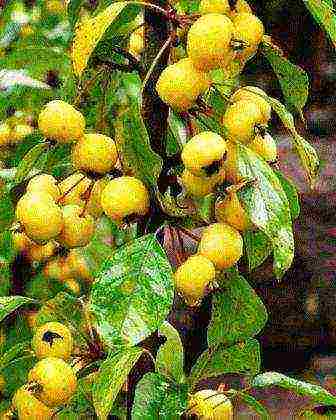 CHINA GOLDEN CHINA GOLDENA promising variety for the summer-autumn ripening period. Strong column. The tree is fruitful and fast-growing.Apples weighing 20 g, of a very attractive bright yellow color, ripen in early September and can hang until frost. The variety is moderately resistant to scab. |
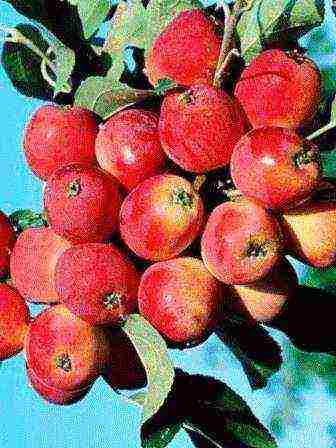 CHINA RED CHINA REDA promising variety of apples for the summer-autumn period of ripening. The column is of a dwarf type of growth. The variety is extremely productive and fast-growing. Bright red apples weighing 20-25 g ripen in early September. |
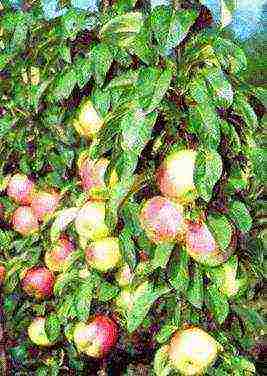 IDOL IDOLA promising large-fruited autumn variety. Trees are semi-dwarfs, closer to dwarfs. Apples are red-striped, weighing up to 250 g. Ripen in early October, well stored until January. Productivity is about 5 kg per tree. The variety is relatively winter hardy, responsive to good care. |
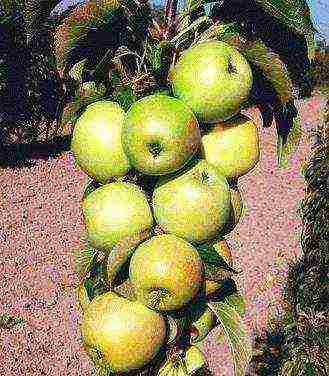 BABY BABYA promising early winter variety. The trees are small and compact - natural dwarfs. Fruiting from the first year when planting in the spring of one-year-olds, and on the 4th-5th trees reach the maximum yield - up to 6 kg per tree. Fruits are truncated-conical, intense yellow and yellow-orange in color, with a shiny thin but firm skin. They ripen in mid-September and keep well for about a month. |
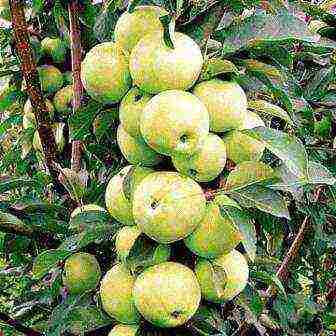 Nectar NectarA promising summer early-growing variety of a columnar apple tree. The trees are compact, semi-dwarfs. Apples 100-140 g each, sweet with a honey aroma, white-yellow, ripen at the end of August. Withstands frosts up to 42 degrees. |
| MOSCOW NECKLACE Winter, early-growing and unusually productive variety of columnar apple. Sometimes, under the weight of the fruit, the trunk is bent. Productivity 8-10 kg per tree. Apples 150-170 g each, dark red, dessert taste. Ripen in mid-September and can be stored until March. High winter hardiness, resistant to pests and diseases. This is the best grade for today. |
| Ostankino Early winter variety. The trees are medium-sized, small and compact. Apples are medium and large - up to 300 g, round-flat, beautiful bright red color. They ripen in mid-September and can be stored until December. Fruit taste with a predominance of sweet dessert. Productivity 5-6 kg per tree. Winter hardiness is very high. |
| THE PRESIDENT Early winter variety of columnar apple. The trees are medium-sized, small-sized, compact, semi-dwarfs. Productivity is 5-6 kg per tree, apples are medium and large (up to 250 g), flat, rich white-yellow color, with thin skin. The taste is sweet and sour, dessert. Ripen in mid-September and can be stored for 1.5 months. |
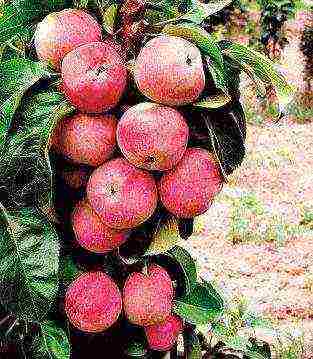 CHERVONETS CHERVONETSAutumn variety, apples weighing 120-160 g, individual up to 350 g, bright red, ripen at the end of September. Needs cross-pollination, in the cold summer, flower buds are laid less than the norm. In the inflorescence, 1-2 fruits are tied. The taste is not inferior to the most valuable varieties. |
In recent years in VNIISPK (Orel) 8 new columnar apple varieties were obtained, most of which are genetically resistant to scab, which makes them especially attractive. We will acquaint you with the features of these varieties.
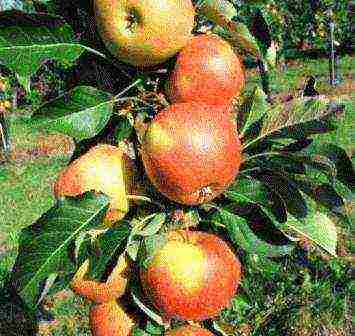 DELIGHT DELIGHTA promising late autumn-early winter variety. A tree of medium vigor, high-yielding, scab immune. Apples 170 g each, yellow with a red blush, can be stored in the refrigerator until February. The pulp is greenish, tender, juicy, sweet and sour. |
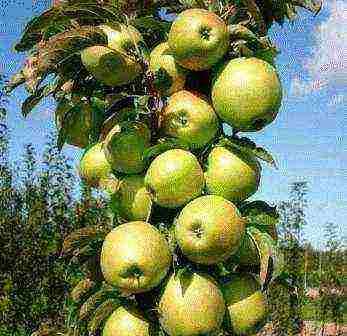 GARLAND GARLANDA promising autumn variety. A tree of medium vigor, immune to scab. Apples 140 g each, yellow-green with a slight blush. The pulp is juicy, tender, sweet and sour taste. The variety is high-yielding, but when overloaded, the apples become very shallow. Differs in almost complete absence of lateral branching. |
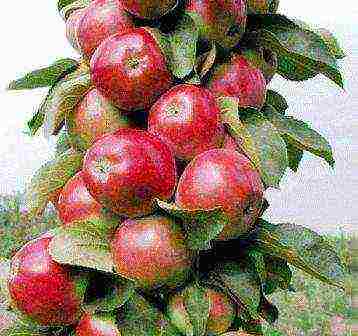 ESENIYA ESENIYAA promising late autumn-early winter variety. A tree of medium vigor, immune to scab. Apples 170 g each, sweet and sour, can be stored in the refrigerator until March. |
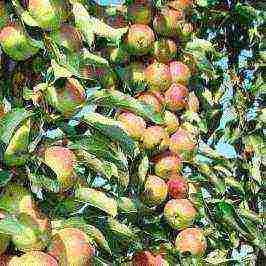 IN MEMORY OF BLYNSKY IN MEMORY OF BLYNSKYA promising late autumn-early winter variety. A tree of medium vigor, immune to scab. Apples 140 g each, conical, greenish yellow with blush and stripes. The pulp is fine-grained, juicy, sweet and sour taste. |
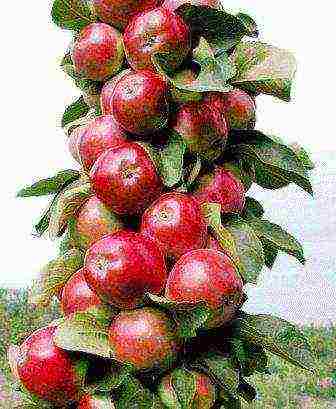 POETRY POETRYA promising late autumn-early winter variety.A tree of medium vigor, with immunity to scab. Apples 180 g or more, slightly flattened, dark red. The pulp is greenish, medium density, fine-grained, very juicy. |
| Priokskoye Winter variety. The tree is of medium vigor, scab resistance is medium. Apples 150 g each, ribbed, greenish pulp, medium density, fine-grained, very tasty. |
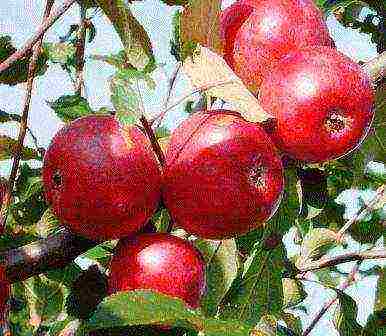 CONSTELLATION CONSTELLATIONA promising winter variety, immune to scab. Apples 125 g each, dark red, delicious. Can be stored in the refrigerator until March. |
Breeder M. V. Kachalkin 10 years ago he began to create decorative red-flowered columnar apple trees.
Today five of its varieties have been successfully tested. As the author of the new forms notes, these columns not only have beautiful flowers, but also quite tasty apples.
| GARNET BRACELET Column of medium vigor with few lateral branches. At the age of 5 years, the height of the tree is 1.3-1.6 m. The flowers are light purple, very large. The trunk is not exposed. Red-purple apples weighing 30-40 g. |
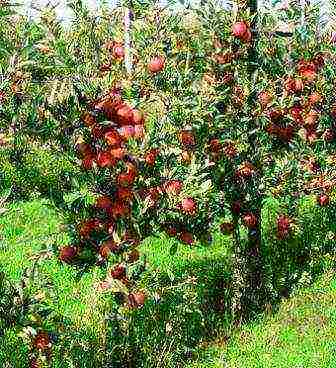 CARMELITE CARMELITEThe column is of a dwarf type of growth. At the age of 5 years, the height of the tree is 1-1.2 m. The flowers are large, dark purple. The trunk is not exposed. Numerous apples are dark lilac, weighing 25-35 g each. |
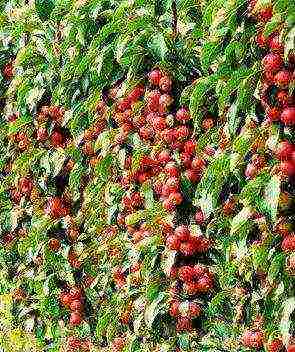 RASPBERRY NECKLACE RASPBERRY NECKLACEThe column is of medium growth. At the age of 5 years, a tree 1.3-1.4 m high without side branches and bare trunk. The flowers are red-purple, red-crimson apples weighing 25-30 g each. |
| Alluring aroma A vigorous, productive column without side branches. At the age of 5 years, the height of the tree is 1.8-2 m. The flowers are large, lilac. Raspberry apples weighing 40-50 g. |
| PINK FAIRY TALE A vigorous columnar apple tree with few lateral branches. At the age of 5 years, the tree is 1.6-1.8 m high. The flowers are purple, very large. The trunk is not exposed. Pink apples weighing 25-30 g. |
Academician N.I. Savelyev and employees at VNIIGi SPR (Michurinsk) also created varieties of columnar apple trees - Gothic, Stela, Strela.
Apple columns were also brought out in Bashkiria: Akhtyam Mansurov, Ural Tau, Kyzyl Mayak.
Note
On the site near Moscow, the author of the article has grown three varieties of columnar apple trees (Currency, President, Ostankino) for 15 years and I can say that no freezing was noticed during this period.
Author - L. Yurina


